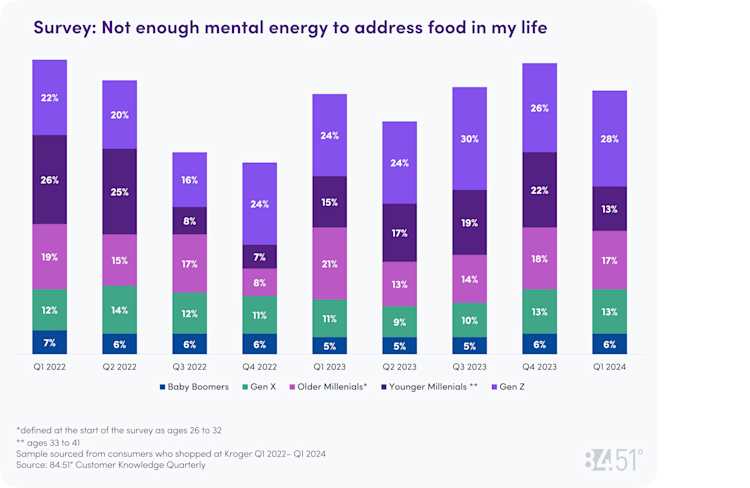
Research: The impact of mental load on food choices

Everyone needs to eat, but not everyone has a sufficient amount of mental energy to devote to food. This is one of the findings that emerged from a two-year quarterly survey conducted from Q1 2022 to Q1 2024, where we asked consumers, did they lack the mental energy to address food in the past three months? A generational breakdown of the results revealed several notable insights and implications for brand marketers.
Why mental load matters
Consumers today are bombarded with an overwhelming amount of choices and information on top of responsibilities, concerns and distractions, leading to decision fatigue and stress. Taking a consumer's mental load – and understanding that levels of mental strain can vary – into consideration demonstrates empathy and could impact purchasing decisions and the overall brand experience.
An increasing lack of mental energy
Despite some outlier quarters, the overall trend shows an increasing sense of "not enough mental energy" since early 2023, particularly for younger generations such as Generation Z. Younger generations were more likely to report insufficient mental energy compared to older cohorts. This could be due to Gen Z and younger millennials having less free time and less experience with food preparation. In contrast, baby boomers have well-established routines and go-to foods, which require less mental effort to prepare.
Baby boomers
Baby boomers consistently reported low difficulties in finding enough mental energy to address food, i.e. plan and prepare meals, ranging from 5% to 7% over the observed periods. This demographic likely has stable routines and preferences.
Generation X
Generation X reported some fluctuations, with percentages ranging from 9% to 14%. There is a noticeable dip in Q2 2023 (9%) but a rise back to 13% by Q4 2023. This group may be balancing multiple responsibilities, leading to variable mental energy.
Millennials
Millennials showed high fluctuations, with older millennials with a low of 8% in Q4 2022 before peaking at 21% in Q1 2023. This could be due to life transitions such as parenthood or career changes. Younger millennials exhibited even more dramatic changes, with a high of 26% in Q1 2022 and a low of 7% in Q4 2022.
Generation Z
In comparison to the other groups, Gen Z struggled the most in finding the mental energy to plan and prepare meals, peaking at 30% in Q3 2023. The results pointed to a general trending increase in mental energy strain. Given that the oldest members of Gen Z are only in their mid-twenties, it remains to be seen how this trend evolves – will it eventually resemble the mental energy levels of older consumers or is this the beginning of a new, lasting trend?
Convenience and mental wellness are key
While all consumers benefit from convenient food options, there is a clear preference for it among younger generations. As our recent study found, Gen Z is more likely to purchase food items that require minimal preparation, such as snacks like crackers and popcorn, and less likely to purchase seafood, eggs and ground beef. Highly convenient, healthy ready-to-eat options or easy-to-prepare meal kits are likely to resonate.
Additionally, customizable food options should cater to the diverse and changing needs of consumers. It’s all about balancing customization with ease; increased flexibility and customization are only a win if it maintains or decreases current customer efforts. Given the increasing mental energy strain, especially among younger consumers, brands that also incorporate messaging around mental health and wellness for products that reduce stress and simplify meal planning will likely be well received.
By simplifying choices, providing clear and concise information and creating user-friendly meal options brands can alleviate some of this mental burden, making it easier for consumers to make decisions and accomplish their food goals. Moreover, recognizing that some consumers have a greater mental load due to various factors—such as busy lifestyles or high-stress environments—allows brands to tailor their strategies to better meet the needs of different consumers. This can foster stronger customer loyalty and enhance brand reputation by demonstrating empathy and understanding of diverse consumer challenges.


Visit our knowledge hub
See what you can learn from our latest posts.


